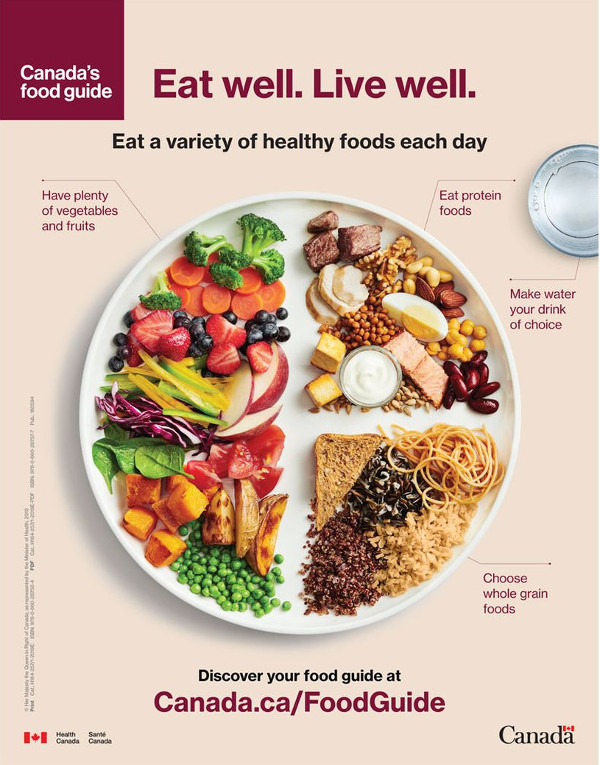Every ten years, Health Canada issues an update of its national guide to healthy eating, Canada’s Food Guide. The most recent version of the document was released this week, and it represents a major departure from the classic focus on ‘Food Groups’ and serving sizes…
 The New Canada’s Food Guide: A radical departure from
The New Canada’s Food Guide: A radical departure from
its previous form and content…
The new 2019 Canada’s Food Guide not only reflects current scientific thinking about what we should all be eating, but also how we should eat. That’s a first. And the Guide simplifies radically its approach to how we should organize our diets.
Overall recommendations…
As you’ve been reading in this space for the past couple of years, the clinical emphasis has been changing on how we organize our diets, and what they should include. The major overall recommendations of the new Guide won’t hold any surprises for regular readers: Eat more Plant-based Proteins and less Meat; more Whole Grains; and more Fresh Fruits and Veggies. And the Guide stresses that we should eat less Processed Food in general. Such foods may be convenient and filling, but they often contain unhealthy amounts of added Sugar and Salt.
No more Food Groups
From 1977 to now, the Guide was organized around four Food Groups: Milk and Milk Products; Meat and alternatives; Grain Products; and Fruits and Vegetables. The new Guide replaces the familiar ‘Rainbow’ visualization of its recommendations with a simple dinner plate showing various foods organized in a pie chart to illustrate how much of each we should consume (see photo, above). Three new ‘categories’ now organize foods under ‘Proteins’ (including Dairy and Meat plus Vegetable-based proteins such as Soy products and Legumes), Whole Grains (marking a major shift in the Guide’s recommendations from the previous edition), and Fruits and Veggies (which are accorded a leading, rather than supporting role in our official new diet).
Less mathematical…
The new Guide does away with serving sizes and numbers and, instead, emphasizes the proportions of the various foods we should be eating each day, as the Dinner Plate graphic illustrates. The cardinal rule is, fill half your plate with Fruits and Veggies and the other half with healthy Proteins and Grains.
Specific recommendations…
Along with recommending we all drink more water through the day and fewer Sugary beverages, the Food Guide weighs in on the social aspects of our eating habits. It’s most important suggestion may be that we not eat alone. As we’ve said in this space before, eating alone can lead to eating too fast and choosing the wrong foods just because they’re easy or convenient to acquire or prepare.
Pushback from agro-industries…
It’s to be expected that those who make their livings producing food products that are de-emphasized in the new Food Guide would protest such moves. Beef and Dairy farmers lobbied Health Canada to ease it’s recommendations on Meat and Milk Products but were not satisfied with the final results as published in the Guide.
Tom Lynch-Staunton, speaking for the Alberta Beef Producers, told The Globe and Mail, “It would be ‘dangerous’ to equate meat with plant-based proteins.” However, the latest scientific and clinical evidence supports a major increase in the consumption of Plant-based Proteins which, unlike Animal Protein sources, don’t carry with them a load of undesirable Saturated Fats.
The Dairy Farmers of Canada warned, in a statement on Tuesday, that the new Guide, “does not reflect the most recent and mounting scientific evidence available.” In the past, the Dairy Farmers stated that de-emphasizing Dairy Products in the new Food Guide would be, “detrimental to the long-term health of future generations.” In reality, the latest science on diet and nutrition agrees with the Guide that eating less Dairy is desirable.
My take…
I can’t help noticing how similar the New Canada’s Food Guide Dinner Plate looks to the Plate used to illustrate the recommendations of the EAT-Lancet world diet recommendations which we looked at just this past Sunday. Both share the same emphases and de-emphases and agree on the rough proportions of various foods we should be eating. That the latest dietary recommendations from such diverse and widely separated organizations correspond so closely is a strong signal to me that those guidelines are legit, and a good bet for anyone who wants to optimize their diet. I’m going to post a printout of the Canada’s Food Guide 2019 Dinner Plate on my Fridge.
~ Maggie J.

